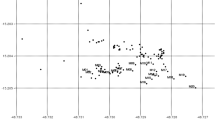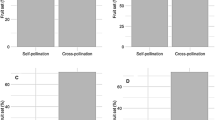Abstract
We investigated pollen dispersal and breeding structure in the tropical tree species Caryocar brasiliense Camb. (Caryocaraceae), using genetic data from ten microsatellite loci. All adult trees (101) within a patch of 8.3 ha were sampled, and from these adults 18 open-pollinated maternal progeny arrays were analyzed (280 seeds from 265 fruits). Most fruits presented only one seed (median equal to 1.000) and mean number of ripened seeds per fruit was 1.053 (SD = 0.828). Our results showed that C. brasiliense presents a mixed-mating system, with 11.4% of self-pollination, multilocus outcrossing rate of t m = 0.891 ± 0.025, and high probability of full-sibship within progeny arrays (r p = 0.135 ± 0.032). Outcrossing rate and self-pollination varied significantly among mother trees. We could detect a maximum pollen dispersal distance of ∼500 m and a mean pollen dispersal distance of ∼132 m. However, most pollination events (80%) occurred at distances less than 200 m. Our results also indicated that pollen dispersal is restricted to a neighborhood of 5.4 ha with rare events of immigration (∼1% N e m = 0.35). C. brasiliense also presents a significant but weak spatial genetic structure (Sp = 0.0116), and extension of pollen dispersal distance was greater than seed dispersal (N b = 86.20 m). These results are most likely due to the foraging behavior of pollinators that may have limited flight range. The highly within-population synchronous flowering, high population density, and clumped distribution reinforce pollinator behavior and affect residence time leading to a short-distance pollen dispersal.



Similar content being viewed by others
References
Augspurger CK (1980) Mass-flowering of a tropical shrub (Hybanthus prunifolius): influence on pollinator attraction and movement. Evolution 34:475–488
Bacles CFE, Lowe AJ, Ennos RA (2006) Effective seed dispersal across a fragmented landscape. Science 311:628
Barret SCH (2003) Mating strategies in flowering plants: the outcrossing–selfing paradigm and beyond. Philos Trans R Soc Lond B 358:991–1004
Barrett SCH, Harder LD (1996) Ecology and evolution of plant mating. Trends Ecol Evol 11:73–79
Bawa KS (1990) Plant–pollinator interactions in tropical rain forests. Ann Rev Ecolog Syst 21:399–422
Burczyk J, Adams WT, Shimizu JY (1996) Mating patterns and pollen dispersal in a natural knobcone pine (Pinus attenuate Lemmon) stand. Heredity 77:251–260
Collevatti RG, Brondani RVP, Grattapaglia D (1999) Development and characterization of microsatellite markers for genetic analysis of a Brazilian endangered tree species Caryocar brasiliense. Heredity 83:748–756
Collevatti RG, Grattapaglia D, Hay JD (2001a) High resolution microsatellite based analysis of the mating system allows the detection of significant biparental inbreeding in Caryocar brasiliense, an endangered tropical tree species. Heredity 86:60–67
Collevatti RG, Grattapaglia D, Hay JD (2001b) Population genetic structure of the endangered tropical tree species Caryocar brasiliense, based on variability at microsatellite loci. Mol Ecol 10:349–356
Collevatti RG, Grattapaglia D, Hay JD (2003) Evidences for multiple maternal lineages of Caryocar brasiliense populations in the Brazilian Cerrado based on the analysis of chloroplast DNA sequences and microsatellite haplotype variation. Mol Ecol 12:105–115
Collevatti RG, Estolano R, Garcia SF, Hay JD (2009) Seed abortion in the bat pollinated Neotropical tree species, Caryocar brasiliense (Caryocaraceae). Botany 87:1110–1115
Dick CW, Etchelecu G, Austerlitz F (2003) Pollen dispersal of tropical trees (Dinizia excelsa: Fabaceae) by native insects and African honeybees in pristine and fragmented Amazonian rainforest. Mol Ecol 12:753–764
Dick CW, Hardy OJ, Jones FA, Petit RJ (2008) Spatial scales of pollen and seed-mediated gene flow in tropical rain forest trees. Trop Plant Biol 1:20–33
Doyle JJ, Doyle JL (1987) Isolation of plant DNA from fresh tissue. Focus 12:13–15
Dunphy BK, Hamrick JL (2007) Estimation of gene flow into fragmented populations of Bursera simaruba (Burseraceae) in the dry-forest life zone of Puerto Rico. Am J Bot 94:1786–1794
Ennos RA (1994) Estimating the relative rates of pollen and seed migration among plant populations. Heredity 72:250–259
Fuchs EJ, Lobo JA, Quesada M (2003) Effects of forest fragmentation and flowering phenology on the reproductive success and mating patterns of the tropical dry forest tree Pachira quinata. Conserv Biol 17:149–157
Ghazoul J (2005) Pollen and seed dispersal among dispersed plants. Biol Rev 80:413–443
Goudet J (2002) FSTAT, a program to estimate and test gene diversities and fixation indices (version 2.9.3.2). http://www.unil.ch/izea/softwares/fstat.html
Goudet J, Raymond M, de Meeds T, Rousset F (1996) Testing differentiation in diploid populations. Genetics 144:1933–1940
Gribel R, Gibbs PE (2002) High outbreeding as a consequence of selfed ovule mortality and single vector bat pollination in the Amazonian tree Pseudobombax munguba (Bombacaceae). Int J Plant Sci 163:1035–1043
Gribel R, Hay JD (1993) Pollination ecology of Caryocar brasiliense (Caryocaraceae) in Central Brazil cerrado vegetation. J Trop Ecol 9:199–211
Hamrick JL, Murawski DA (1990) The breeding structure of tropical tree populations. Plant Species Biol 5:157–165
Hardy OJ, Vekemans X (2002) SPAGeDi: a versatile computer program to analyse spatial genetic structure at the individual or population levels. Mol Ecol Notes 2:618–620
Hay JD, Bizerril MX, Calouro AM et al (2000) Comparação do padrão da distribuição espacial em escalas diferentes de espécies nativas do cerrado, em Brasília, DF. Rev Bras Bot 23:341–347
Kalinowski ST, Taper ML, Marshall TC (2007) Revising how the computer program Cervus accommodates genotyping error increases success in paternity assignment. Mol Ecol 16:1099–1106
Klink CA, Machado RB (2005) Conservation of the Brazilian Cerrado. Conserv Biol 19:707–713
Lacerda AEB, Kanashiro M, Sebbenn AM (2008) Long-pollen movement and deviation of random mating in a low-density continuous population of a tropical tree Hymenaea courbaril in the Brazilian Amazon. Biotropica 40:462–470
Latouche-Hallé C, Ramboer A, Bandou E, Caron H, Kremer A (2004) Long-distance pollen flow and tolerance to selfing in a Neotropical tree species. Mol Ecol 13:1055–1064
Levin DA (1978) Pollinator behavior and the breeding structure of plant population. In: Richards AJ (ed) The pollination of flowers by insects. Academic, London, pp 133–150
Levin DA (1988) The paternity pool plants. Am Nat 132:309–317
Lobo JA, Quesada M, Stoner KE (2005) Effects of pollination by bats on the mating system of Ceiba pentandra (Bombacaceae) populations in two tropical life zones in Costa Rica. Am J Bot 92:370–376
Loiselle BA, Sork VL, Nason JD, Graham C (1995) Genetic structure of a tropical understorey shrub, Psychotria officinalis (Rubiaceae). Am J Bot 82:1420–1425
Marshall TC, Slate J, Kruuk LEB, Pemberton M (1998) Statistical confidence for likelihood-based paternity inference in natural populations. Mol Ecol 7:639–655
McCauley DE (1994) Contrasting the distribution of chloroplast DNA and allozyme polymorphism among local populations of Silene alba: implications for studies of gene flow in plants. Proc Natl Acad Sci U S A 91:8127–8131
Muller F, Voccia M, Bâ A, Bouvet JM (2008) Genetic diversity and gene flow in a Caribbean tree Pterocarpus officinalis Jacq.: a study based on chloroplast and nuclear microsatellites. Genetica 135:185–198. doi:10.1007/s10709-008-9268-4
Murawski DA, Hamrick JL (1991) The effect of the density of flowering individuals on the mating systems of nine tropical tree species. Heredity 67:167–174
Murawski DA, Hamrick JL (1992a) Mating system and phenology of Ceiba pentandra (Bombacaceae) in Central Panama. J Hered 83:401–404
Murawski DA, Hamrick JL (1992b) The mating system of Cavanillesia platanifolia under extremes of flowering-tree density: a test of predictions. Biotropica 24:99–101
Nason JD, Herre EA, Hamrick JL (1998) The breeding structure of a tropical keystone plant resource. Nature 391:685–687
Nei M (1978) Estimation of average heterozygosity and genetic distance from a small number of individual. Genetics 89:583–590
Oosterhout CV, Hutchinson WF, Wills DPM, Shipley P (2004) MICRO-CHECKER: software for identifying and correcting genotyping errors in microsatellite data. Mol Ecol Notes 4:535–538
Paetkau D, Calvert W, Stirling I, Strobeck C (1995) Microsatellite analysis of population structure in Canadian polar bears. Mol Ecol 4:347–354
Ratter JA, Bridgewater S, Ribeiro JF (2003) Analysis of the floristic composition of the Brazilian Cerrado vegetation. III. Comparison of the woody vegetation of 376 areas. Edinb J Bot 60:57–109
Ritland K (1988) The genetic mating structure of subdivided populations. II. Correlated mating models. Theor Popul Biol 34:320–346
Ritland K (2002) Extensions of models for the estimation of mating systems using n independent loci. Heredity 88:221–228
Ritland K, Jain S (1981) A model for the estimation of outcrossing rate and gene frequencies using n independent loci. Heredity 47:35–52
Rousset F (1997) Genetic differentiation and estimation of gene flow from F-statistics under isolation by distance. Genetics 145:1219–1228
Silva JF, Fariñas MR, Felfili JM, Klink CA (2006) Spatial heterogeneity, land use and conservation in the Cerrado region of Brazil. J Biogeogr 33:536–548
Sokal RR, Rohlf F (1995) Biometry: the principles and practices of statistics in biological research, 3rd edn. Freeman, New York
Trapnell DW, Hamrick JL (2005) Mating patterns and gene flow in the neotropical epiphytic orchid, Laelia rubescens. Mol Ecol 14:75–84
Vekemans X, Hardy OJ (2004) New insights from fine-scale spatial genetic structure analyses in plant populations. Mol Ecol 13:921–935
Ward M, Dick CW, Gribel R, Lowe AJ (2005) To self, or not to self…A review of outcrossing and pollen-mediated gene flow in neotropical trees. Heredity 95:246–254. doi:10.1038/sj.hdy.6800712
Weir BS (1996) Genetic data analysis II. Sinauer, Sunderland
Weir BS, Cockerham CC (1984) Estimating F-statistics for the analysis of population structure. Evolution 38:1358–1370
Westneat DF, Webster MS (1994) Molecular analysis of kinship in birds: interesting questions and useful techniques. In: Schierwater B, Streit B, Wagner GP, DeSalle R (eds) Molecular ecology and evolution: approaches and applications. Birkhiiuser, Basel, pp 91–126
White GM, Boshier DH (2000) Fragmentation in Central American dry forests: genetic impacts on Swietenia humilis (Meliaceae). In: Young AG, Clarke GM (eds) Genetics, demography and viability of fragmented populations. Cambridge University Press, Cambridge, pp 293–311
White GM, Boshier DH, Powell W (2002) Increased pollen flow counteracts fragmentation in a tropical dry forest: an example from Swietenia humilis Zuccarini. Proc Natl Acad Sci U S A 99:2038–2042
Wright S (1940) Breeding structure of populations in relation to speciation. Am Nat 74:232–248
Wright S (1943) Isolation by distance. Genetics 28:114–138
Wright S (1946) Isolation by distance under diverse system of mating. Genetics 31:39–59
Wright S (1965) The interpretation of population structure by F-statistics with special regard to system of mating. Evolution 19:395–420
Acknowledgements
This work was supported by a grant from CNPq (Brazilian Ministry of Science and Technology) to R.G.C. We wish to thank Mardônio Timo for his kind help in the field work.
Author information
Authors and Affiliations
Corresponding author
Additional information
Communicated by: D. Grattapaglia
Rights and permissions
About this article
Cite this article
Collevatti, R.G., Estolano, R., Garcia, S.F. et al. Short-distance pollen dispersal and high self-pollination in a bat-pollinated neotropical tree. Tree Genetics & Genomes 6, 555–564 (2010). https://doi.org/10.1007/s11295-010-0271-4
Received:
Revised:
Accepted:
Published:
Issue Date:
DOI: https://doi.org/10.1007/s11295-010-0271-4




